CADILLAC FLEETWOOD 1994 Owners Manual
Manufacturer: CADILLAC, Model Year: 1994, Model line: FLEETWOOD, Model: CADILLAC FLEETWOOD 1994Pages: 398, PDF Size: 19.19 MB
Page 91 of 398
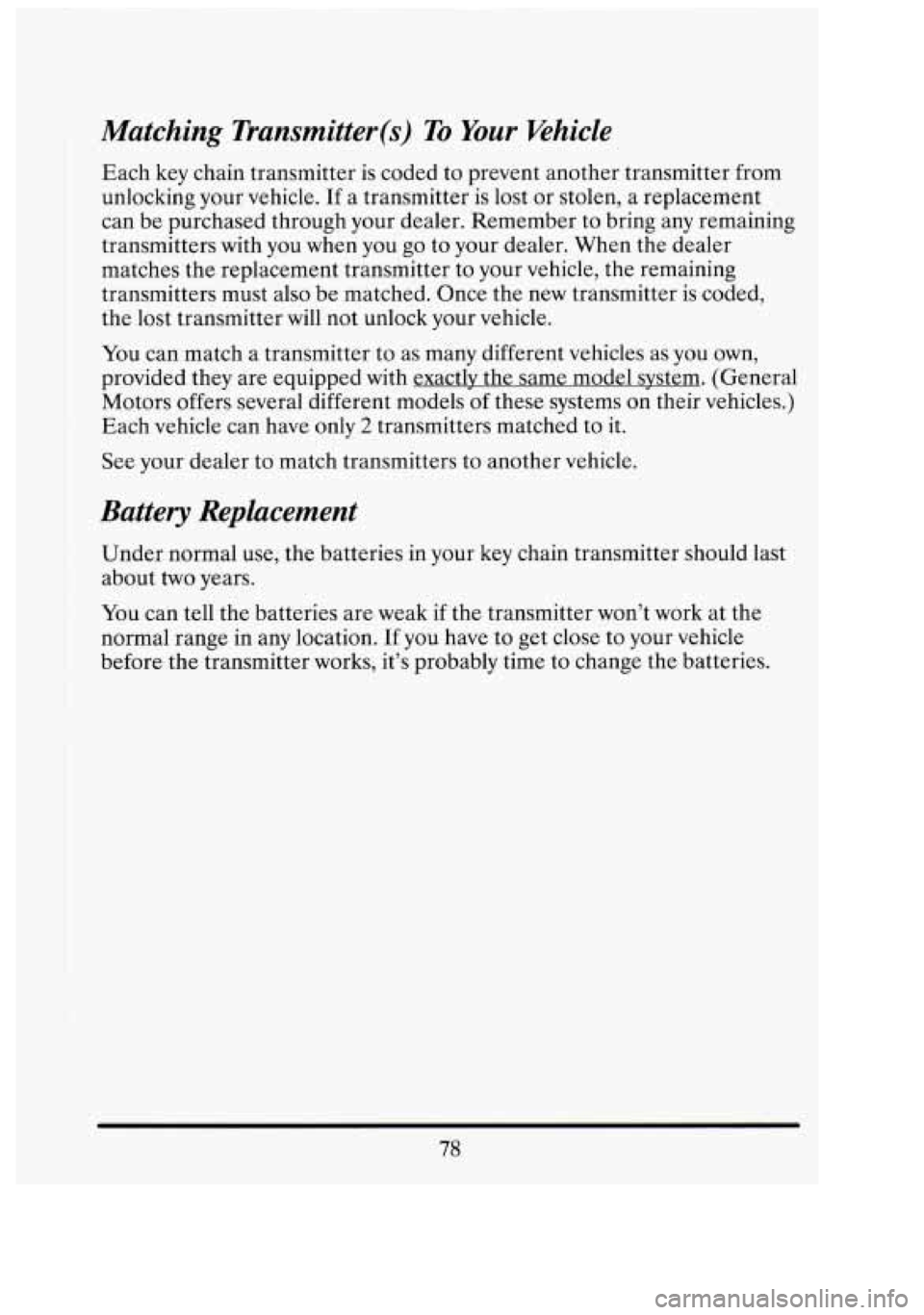
Matching Transmitter(s) To Your Vehicle
Each key chain transmitter is coded to prevent another transmitter from
unlocking your vehicle.
If a transmitter is lost or stolen, a replacement
can be purchased through your dealer. Remember to bring any remaining
transmitters with you when you go to your dealer. When the dealer
matches the replacement transmitter
to your vehicle, the remaining
transmitters must also be matched. Once the new transmitter is coded,
the lost transmitter will not unlock your vehicle.
You can match a transmitter to as many different vehicles as you own,
provided they are equipped with exactly the same model system. (General
Motors offers several different models
of these systems on their vehicles.)
Each vehicle can have only 2 transmitters matched to it.
See your dealer to match transmitters to another vehicle.
Battery Replacement
Under normal use, the batteries in your key chain transmitter should last
about
two years.
You can tell the batteries are weak if the transmitter won’t work at the
normal range in any location. If you have to get close to your vehicle
before the transmitter works, it’s probably time to change the batteries.
78
o/
E 1
Page 92 of 398
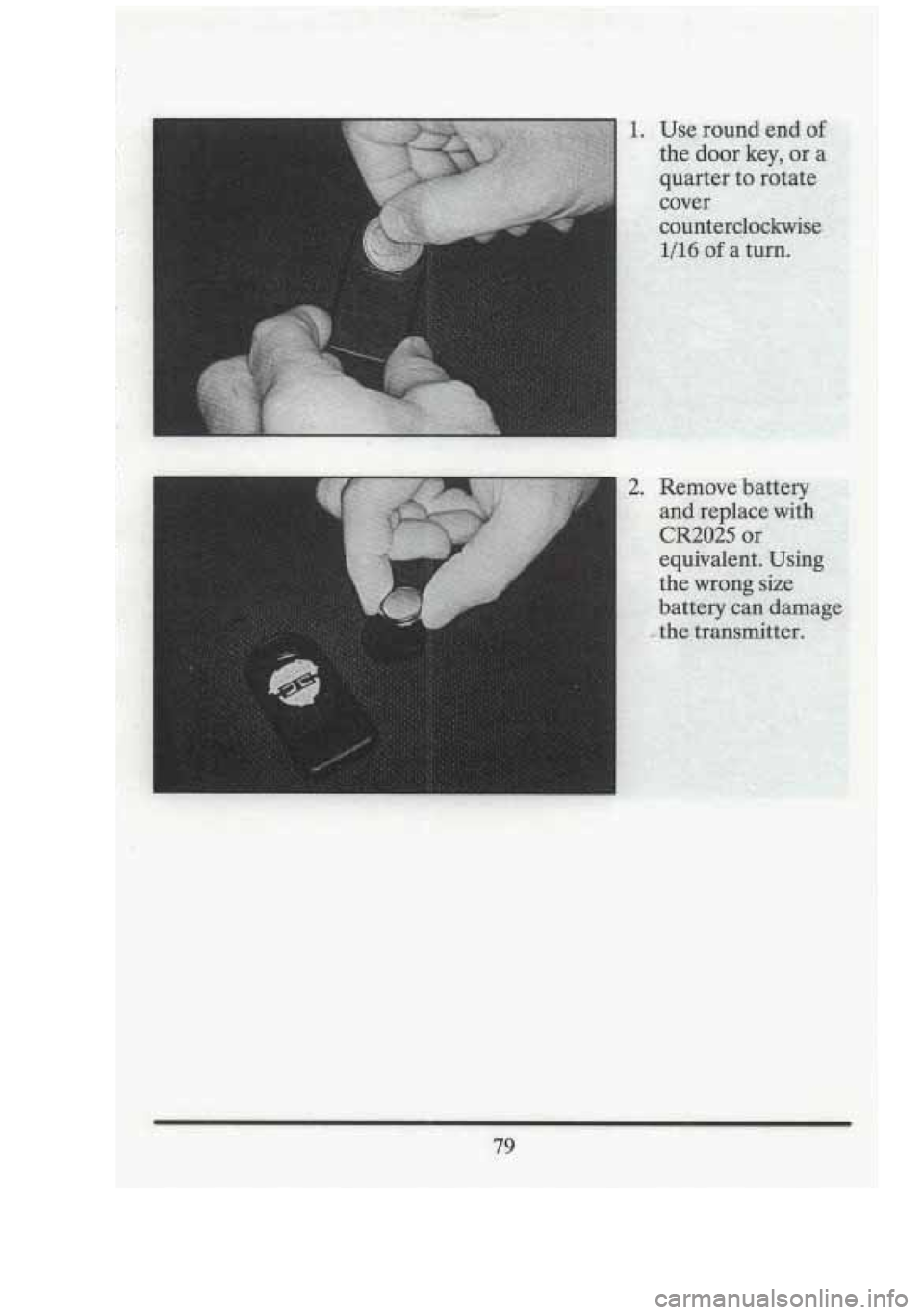
n
Page 93 of 398
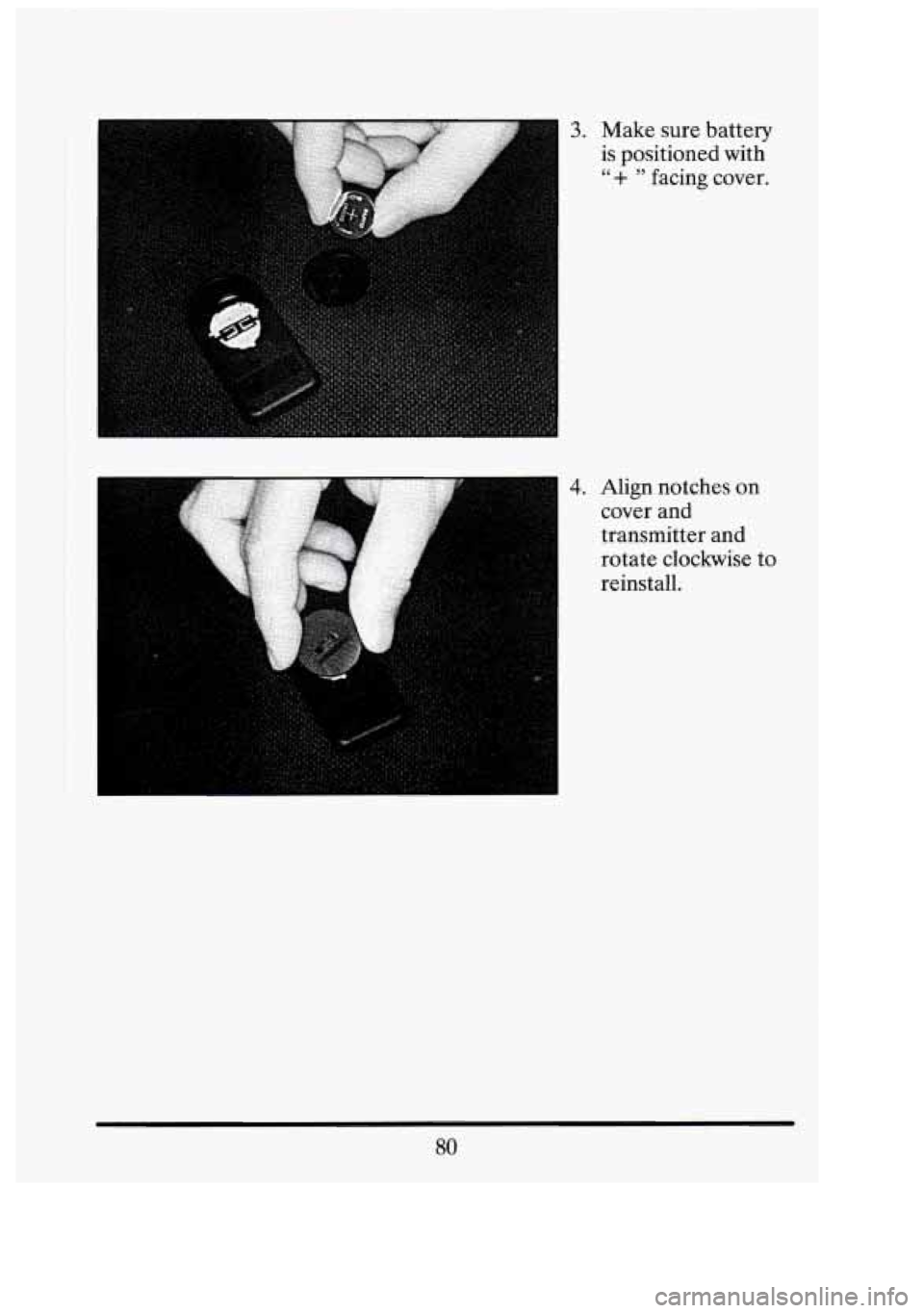
3.
4.
Make sure battery
is positioned with
" + " facing cover.
mlgn notches on
cover and
transmitter and
rotate clockwise to
reinstall.
80
I
1
Page 94 of 398
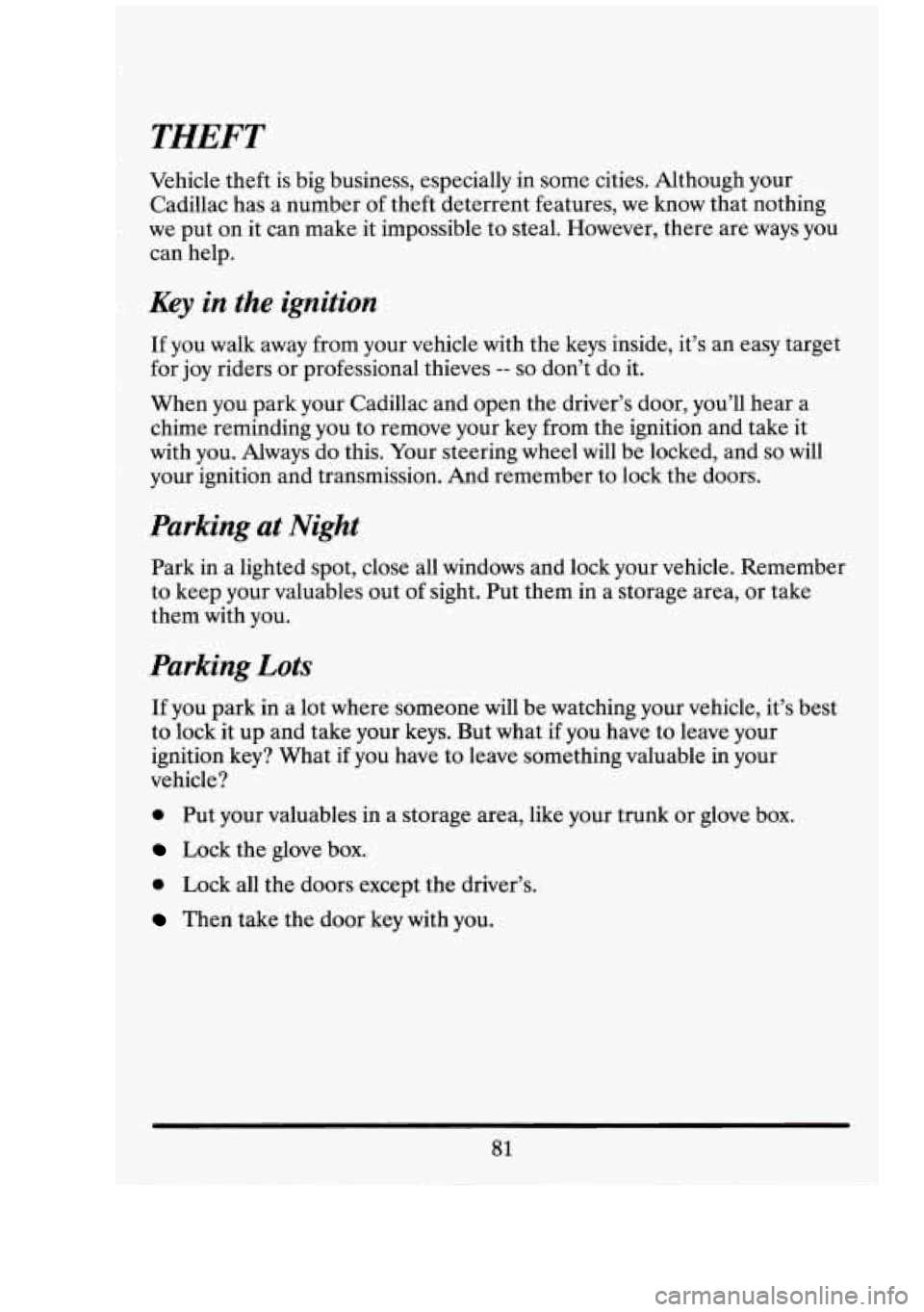
THEFT
Vehicle theft is big business, especially in some cities. Although your
Cadillac has a number of theft deterrent features,
we know that nothing
we put on it can make it impossible to steal. However, there are ways you
can help.
Key in the ignition
If you walk away from your vehicle with the keys inside, it’s an easy target
for joy riders or professional thieves
-- so don’t do it.
When you park your Cadillac and open the driver’s door, you’ll hear a
chime reminding you to remove your key from the ignition and take it
with you. Always do this. Your steering wheel will be locked, and
so will
your ignition and transmission. And remember to lock the doors.
Parking at Night
Park in a lighted spot, close all windows and lock your vehicle. Remember
to keep your valuables out
of sight. Put them in a storage area, or take
them with you.
Parking Lots
If you park in a lot where someone will be watching your vehicle, it’s best
to lock it up and take your keys. But what if you have to leave your
ignition key? What if you have to leave something valuable in your
vehicle?
0 Put your valuables in a storage area, like your trunk or glove box.
Lock the glove box.
0 Lock all the doors except the driver’s.
Then take the door key with you.
81
Page 95 of 398
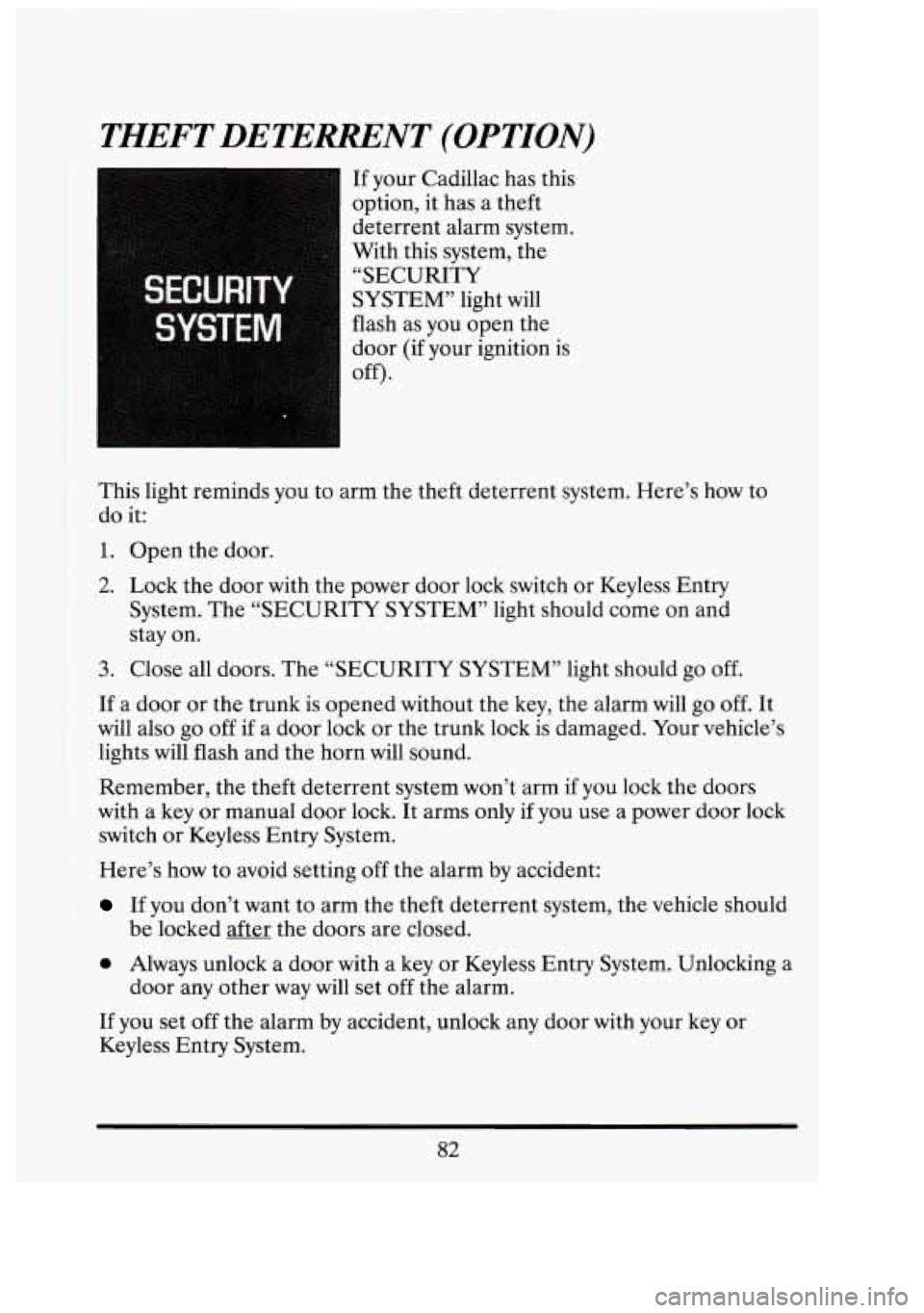
THEFT DETEWNT (OPTION)
SECURIT”
SYSTFM
If your Cadillac has this
option, it has a theft
deterrent alarm system.
With this system,
the
“SECURITY
SYSTEM” light
will
flash as you open the
door (if your ignition
is
off).
This light reminds you to arm the theft deterrent system. Here’s how to
do it:
1. Open the door.
2. Lock the door with the power door lock switch or Keyless Entry
System. The “SECURITY SYSTEM” light should come on and
stay on.
3. Close all doors. The “SECURITY SYSTEM” light should go off.
If a door or the trunk is opened without the key, the alarm
will go off. It
will also go
off if a door lock or the trunk lock is damaged. Your vehicle’s
lights will flash and the horn will sound.
Remember, the theft deterrent system won’t arm
if you lock the doors
with a key or manual door lock. It arms only
if you use a power door lock
switch or Keyless Entry System.
Here’s how to avoid setting off the alarm by accident:
-1
-1
I
If you don’t want to arm the theft deterrent system, the vehicle should
be locked after the doors are closed.
0 Always unlock a door with a key or Keyless Entry System. Unlocking a
If you set off the alarm by accident, unlock any door with your key or
Keyless Entry System.
door
any other way will set
off the alarm.
82
Page 96 of 398
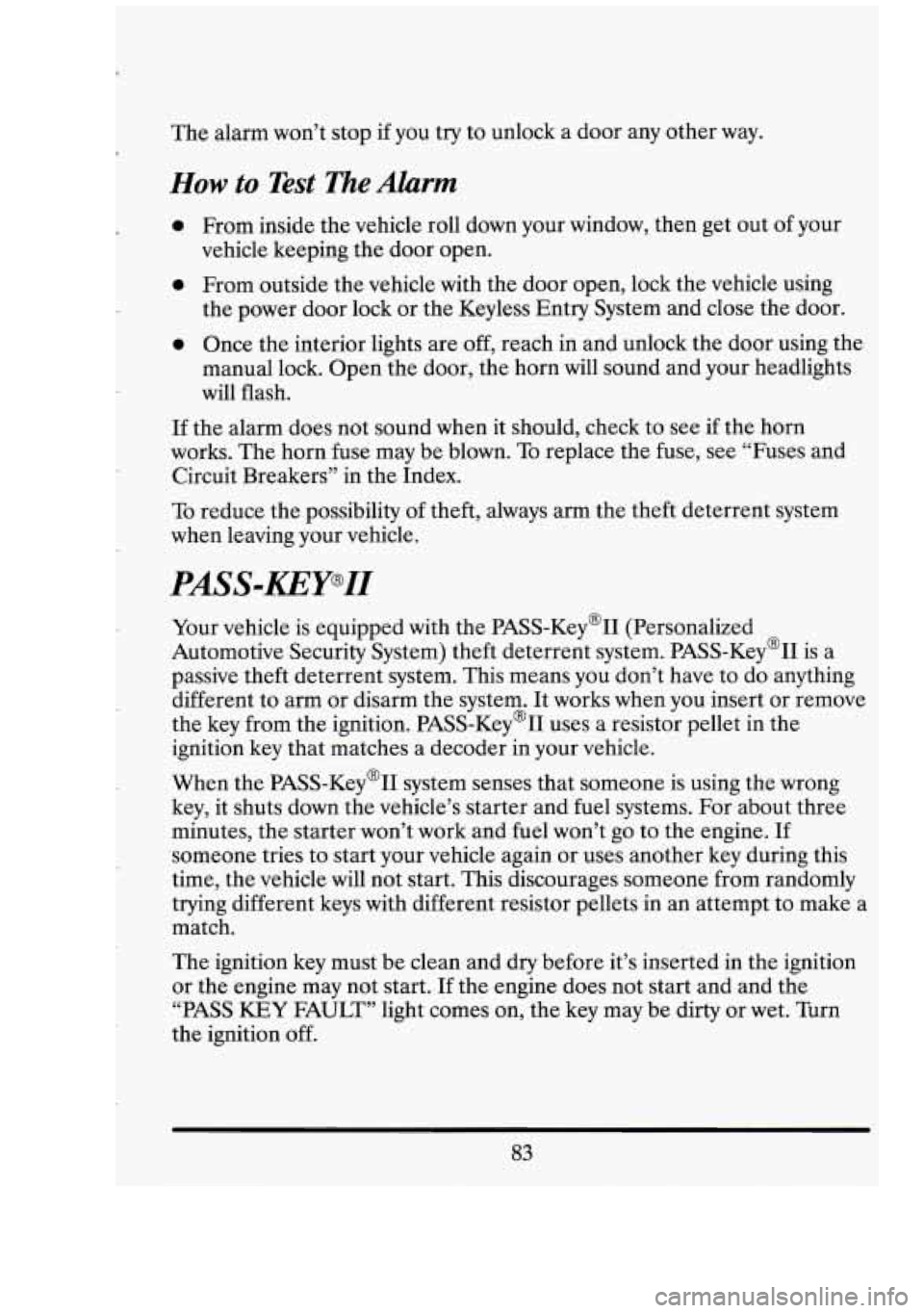
The alarm won’t stop if you try to unlock a door any other way.
How to Test The Alarm
r 0 From inside the vehicle roll down your window, then get out of your
vehicle keeping the door open.
0 From outside the vehicle with the door open, lock the vehicle using
the power door lock or the Keyless Entry System and close the door.
0 Once the interior lights are off, reach in and unlock the door using the
manual lock. Open the door, the horn will sound and your headlights
will flash.
If the alarm does not sound when it should, check to see
if the horn
works. The horn fuse may be blown. To replace the fuse, see “Fuses and
Circuit Breakers” in the Index.
To reduce the possibility of theft, always arm the theft deterrent system
when leaving your vehicle.
PASS-KEY@II
Your vehicle is equipped with the PASS-Key@II (Personalized
Automotive Security System) theft deterrent system. PASS-Key@II
is a
passive theft deterrent system. This means you don’t have to do anything
different to arm or disarm the system. It works when you insert or remove
the
key from the ignition. PASS-Key@II uses a resistor pellet in the
ignition key that matches a decoder in your vehicle.
When the PASS-Key@II system senses that someone is using the wrong
key, it shuts down the vehicle’s starter and fuel systems. For about three
minutes, the starter won’t work and fuel won’t
go to the engine. If
someone tries to start your vehicle again or uses another key during this
time, the vehicle will not start. This discourages someone from randomly
trying different keys with different resistor pellets in an attempt to make a
match.
The ignition
key must be clean and dry before it’s inserted in the ignition
or the engine may not start. If the engine does not start and and the
“PASS
KEY FAULT” light comes on, the key may be dirty or wet. Turn
the ignition off.
83
Page 97 of 398
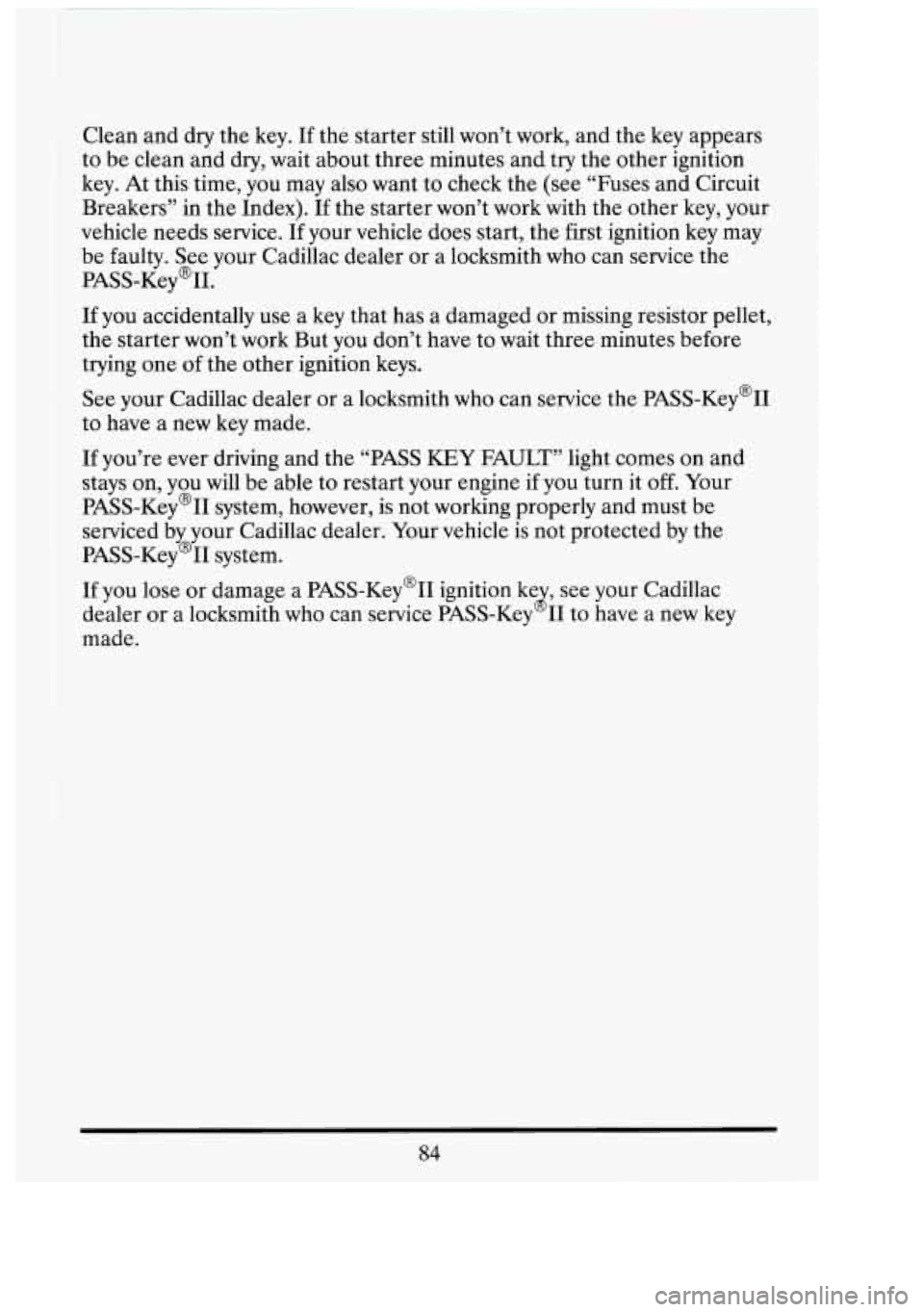
Clean and dry the key. If the starter still won’t work, and the key appears
to be clean and dry, wait about three minutes and try the other ignition
key. At this time, you may also want to check the (see “Fuses and Circuit
Breakers” in the Index). If the starter won’t work with the other key, your
vehicle needs service. If your vehicle does start, the first ignition key may
be faulty. See your Cadillac dealer or a locksmith who can service the
PASS-Key@II.
If you accidentally use a
key that has a damaged or missing resistor pellet,
the starter won’t work But you don’t have to wait three minutes before
trying one of the other ignition keys.
See your Cadillac dealer or a locksmith who can service the PASS-Key@II
to have
a new key made.
If you’re ever driving and the “PASS KEY FAULT” light comes on and
stays on, you will be able to restart your engine if you turn it off. Your
PASS-Key@II system, however, is not working properly and must be
serviced by your Cadillac dealer. Your vehicle is not protected by the
PASS-Key@II system.
If you lose or damage a PASS-Key@II ignition ke
, see your Cadillac
dealer or a locksmith who can service PASS-Key I1 to have a new key
made. J
o/
‘U I
84
Page 98 of 398
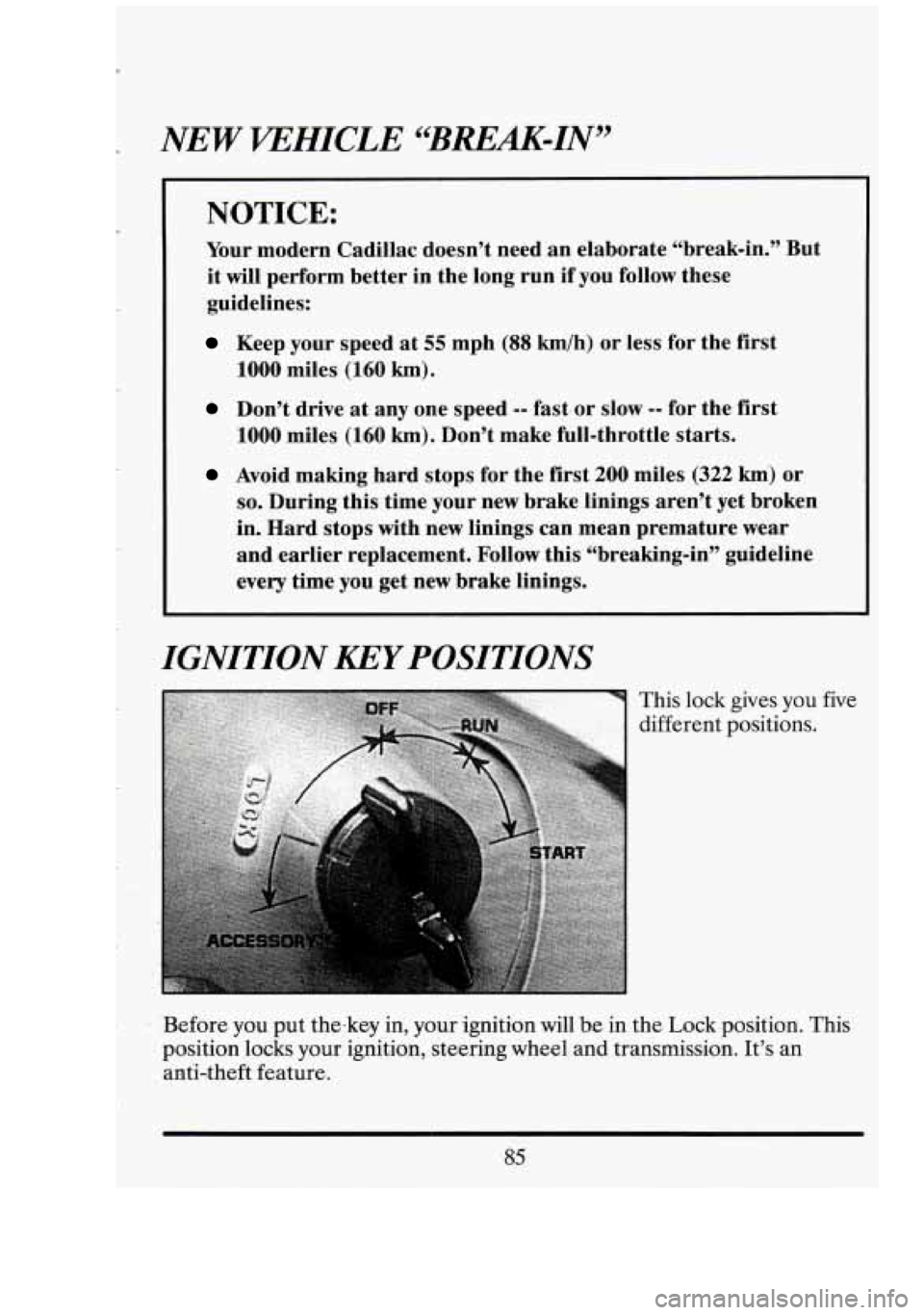
NOTICE:
Your modern Cadillac doesn’t need .an elaborate “break-in.” But
it will perform better in the long run if you follow these
guidelines:
Keep your speed at 55 mph (88 km/h) or less for the first
1000 miles (160 km).
Don’t drive at any one speed -- fast.or slow -- for the first
1000 miles (160 km). Don’t make full-throttle starts.
Avoid making hard stops for the first 200 miles (322 km) or
so. During this time your new brake linings aren’t yet broken
in. Hard stops with new linings can mean premature wear
and earlier replacement. Follow this “breaking-in’’ guideline
every time
you get new brake linings.
IGNITIQN KEY POSITIONS
This lock
different : gives you
positions. five
‘Before you put the-key in, your ignition will
be in the Lock position. This
position locks your ignition, steering wheel and transmission. It’s an
anti-:theft ,feature.
Page 99 of 398
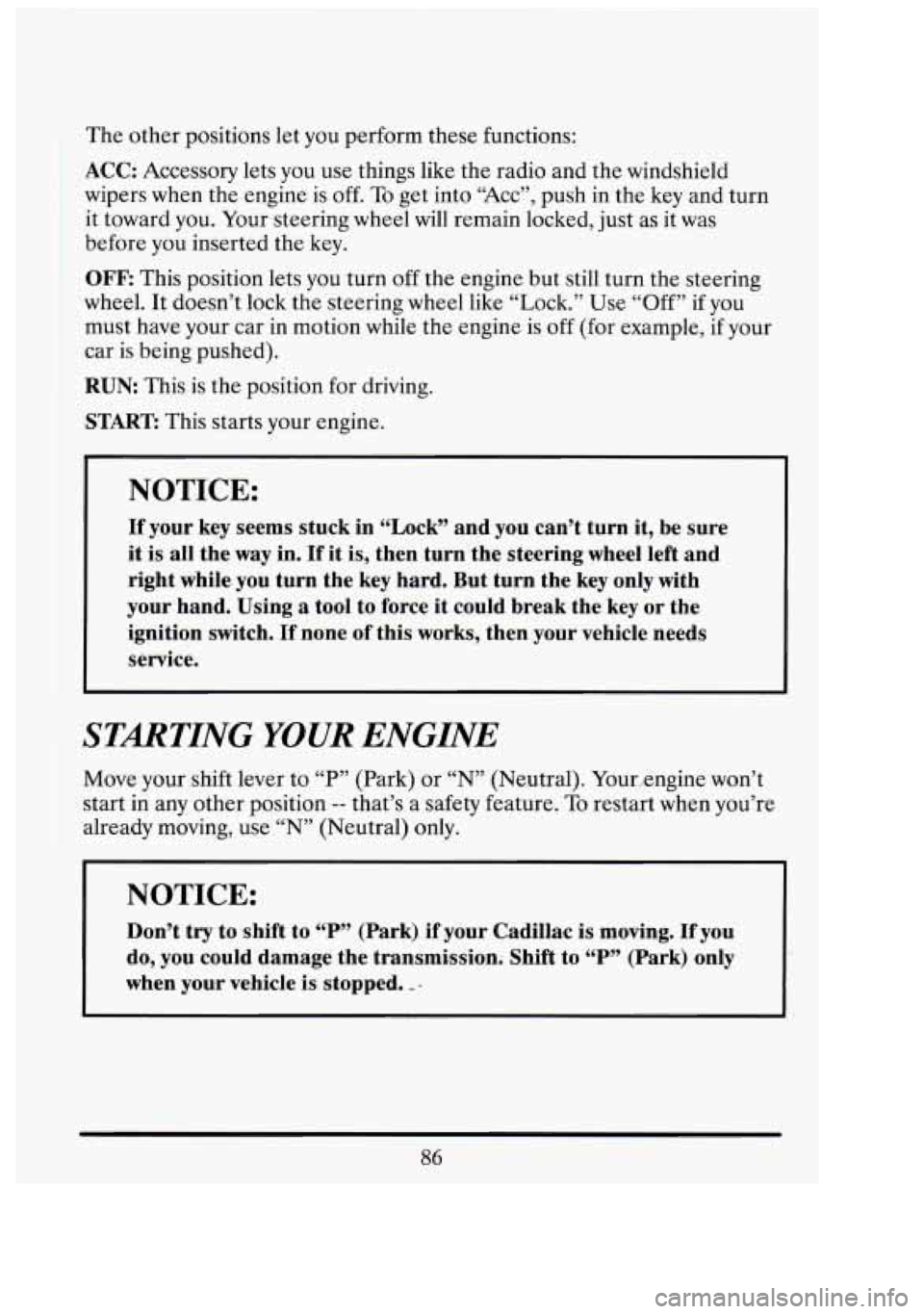
I
The other positions let you perform these functions:
ACC: Accessory lets you use things like the radio and the windshield
wipers when the engine is
off. To get into “ACC”, push in the key and turn
it toward
you. Yoursteeringwheel will remain locked, just as it was
before you inserted the key.
OFF: This position lets you turn off the engine but still turn the steering
wheel. It doesn’t lock the steering wheel like “Lock.” Use “Off”
if you
must have your car in motion while the engine is
off (for example, if your
car is being pushed).
RUN This is the position for driving.
START This starts your engine.
NOTICE:
If your key seems stuck in “Lock” and you can’t turn it, be sure
it
is all the way in. If it is, then turn the steering wheel left and
right while. you turn the key hard. But turn the key only with
your hand. Using
a tool to force it could break the key or the
ignition switch.
If none of this works, then your vehicle needs
service.
STARTING YOUR ENGINE
Move your shift lever to “P” (Park) or “N” (Neutral). Your,,engine won’t
start in
any other position -- that’s a safety feature. To restart when you’re
already moving, use “N” (Neutral) only.
NOTICE:
Don’t try to shift to “P” (Park).. if your Cadillae is moving. If you
do, you could .damage the transmission. Shift to “P” (Park) only
when your vehicle
is stopped. ”. .
1
W I
D
I
I
-
Page 100 of 398
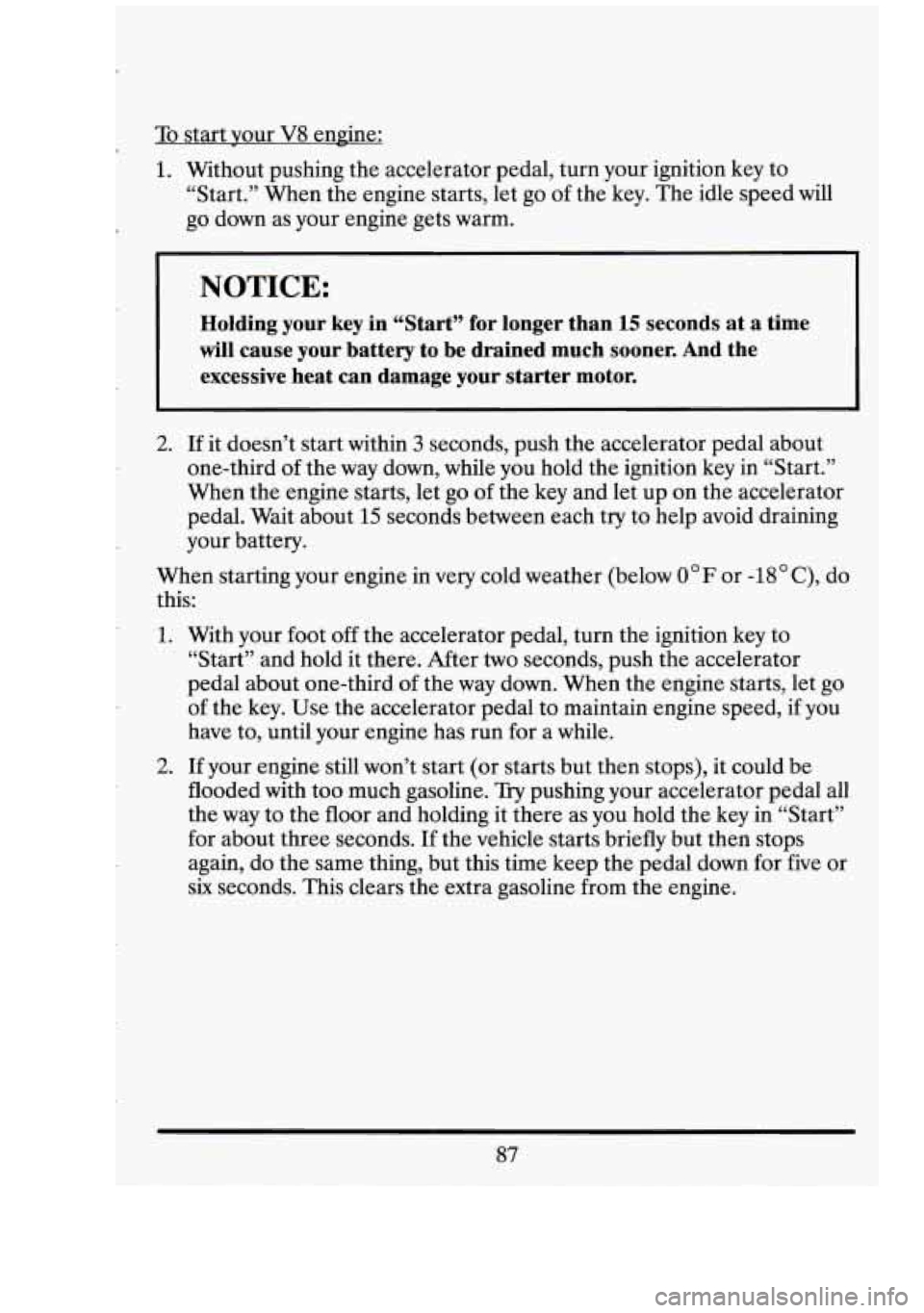
To start vour V8 engine:
1. Without pushing the accelerator pedal, turn your ignition key to
“Start.” When the engine starts, let
go of the key. The idle speed will
go down as your engine gets warm.
NOTICE:
Holding your key in “Start” for longer than 15 seconds at a time
will cause your battery to be drained much sooner.
And the
excessive heat can damage your starter motor.
2. If it doesn’t start within 3 seconds, push the accelerator pedal about
one-third of the way down, while you hold the ignition key
in “Start.”
When the engine starts, let go of the
key and let up on the accelerator
pedal. Wait about
15 seconds between each try to help avoid draining
your battery.
When starting your engine in very cold weather (below
O°F or -18 C), do
this:
1. With your foot off the accelerator pedal, turn the ignition key to
“Start” and hold it there. After two seconds, push the accelerator
pedal about one-third of the way down. When the engine starts, let go
of the key. Use the accelerator pedal to maintain engine speed, if you
have to, until your engine has run for a while.
2. If your engine still won’t start (or starts but then stops), it could be
flooded with too much gasoline. Try pushing your a,ccelerator pedal all
the way to the floor and holding it there as you hold the key in “Start”
for about three seconds.
If the vehicle starts briefly but then stops
again, do the same thing, but this time keep the pedal down for five or
six seconds. This clears the extra gasoline from the engine.
87